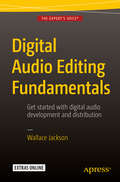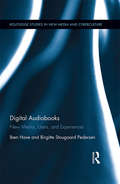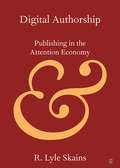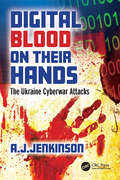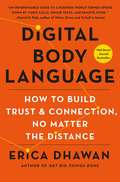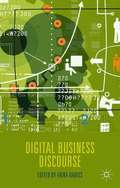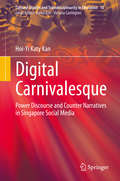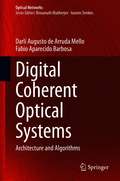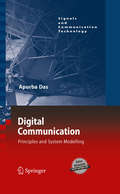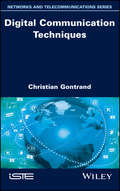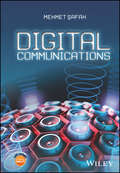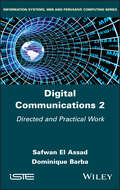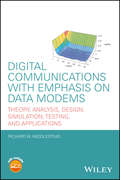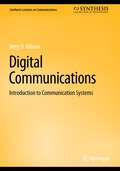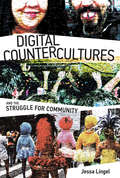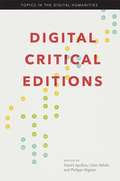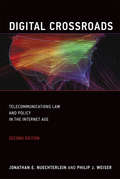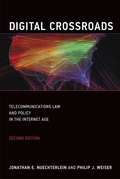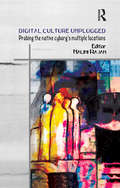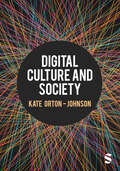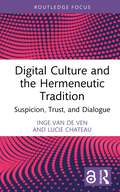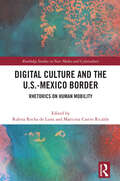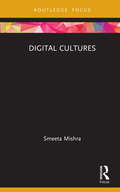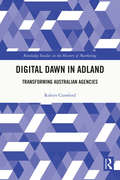- Table View
- List View
Digital Audio Editing Fundamentals
by Wallace JacksonThis concise book builds upon the foundational concepts of MIDI, synthesis, and sampled waveforms. It also covers key factors regarding the data footprint optimization work process, streaming versus captive digital audio new media assets, digital audio programming and publishing platforms, and why data footprint optimization is important for modern day new media content development and distribution. Digital Audio Editing Fundamentals is a new media mini-book covering concepts central to digital audio editing using the Audacity open source software package which also apply to all of the professional audio editing packages. The book gets more advanced as chapters progress, and covers key concepts for new media producers such as how to maximize audio quality and which digital audio new media formats are best for use with Kindle, Android Studio, Java, JavaFX, iOS, Blackberry, Tizen, Firefox OS, Chrome OS, Opera OS, Ubuntu Touch and HTML5. What you'll learn Industry terminology involved in digital audio editing, synthesis, sampling, analysis and processing The work process which comprises a fundamental digital audio editing, analysis, and effects pipeline The foundational audio waveform sampling concepts that are behind modern digital audio publishing How to install, and utilize, the professional, open source Audacity digital audio editing software Concepts behind digital audio sample resolution and sampling frequency and how to select settings How to select the best digital audio data codec and format for your digital audio content application How to go about data footprint optimization, to ascertain which audio formats give the best results Using digital audio assets in computer programming languages and content publishing platforms Who this book is for Primary Audience: Podcasters, Bloggers, Composers, Musicians, Sound Designers, Digital Signage Content Producers, e-Learning Content Creators. Secondary Audience: Website Developers, Android Developers, iOS Developers, Multimedia Producers, Rich Internet Application (RIA) Programmers, Game Designers, User Interface Designers, User Experience Designers, Teachers, Broadcasters, Digital Content Publishers. Table of Contents Chapter 1 The Foundation of Digital Audio: The Sound Wave Chapter 2 The History of Digital Audio: MIDI and Synthesis Chapter 3 The Reproduction of Digital Audio: Data Sampling Chapter 4 The Transmission of Digital Audio: Data Formats Chapter 5 The Cleanup of Digital Audio: Noise Removal Chapter 6 The Isolation of Digital Audio: Trimming Tools Chapter 7 The Manual Labor of Digital Audio: Sample Editing Chapter 8 The Algorithms of Digital Audio: Audio Processing Chapter 9 A Visualization of Digital Audio: Spectral Analysis Chapter 10 The Compositing of Digital Audio: Using Tracks Chapter 11 The Creation of Digital Audio: Tone Generation Chapter 12 The Data Footprint of Digital Audio: Compression Chapter 13 The Automation of Digital Audio: Programming Chapter 14 Publishing Digital Audio: Delivery Platforms
Digital Audiobooks: New Media, Users, and Experiences (Routledge Studies in New Media and Cyberculture)
by Iben Have Birgitte Stougaard PedersenAudiobooks are rapidly gaining popularity with widely accessible digital downloading and streaming services. This book engages with the digital form of audiobooks, framing audiobook listening as both a remediation of literature and an everyday activity that creates new reading experiences that can be compared to listening to music or the radio. Have and Stougaard Pedersen challenge the historical notion that audiobook listening is a compensatory activity or a second-rate reading experience, while seeking to establish a dialogue between sound studies and media studies, comparative literature, aesthetics, and sociology.
Digital Authorship: Publishing in the Attention Economy (Elements in Publishing and Book Culture)
by R. Lyle SkainsThis Element looks at contemporary authorship via three key authorial roles: indie publisher, hybrid author, and fanfiction writer. The twenty-first century's digital and networked media allows writers to disintermediate the established structures of royalty publishing, and to distribute their work directly to - and often in collaboration with - their readers. This demotic author, one who is 'of the people', often works in genres considered 'popular' or 'derivative'. The demotic author eschews the top-down communication flow of author > text > reader, in favor of publishing platforms that generate attention capital, such as blogs, fanfiction communities, and social media.
Digital Blood on Their Hands: The Ukraine Cyberwar Attacks
by Andrew JenkinsonCyberattacks are nothing particularly new to the world and Ukraine had suffered many such attacks by Russia over recent years. Russia had knowingly been exploiting Ukraine’s digital vulnerabilities as a proving ground for nearly a decade. Malware such as Sandworm and BlackEnergy had caused untold damage to the Ukrainian population and government previously, which allowed Russia to perfect cyberattacks for further, more global events. Russia had been planting cyber sleeper digital cells for years, especially in the US and the UK. Then, coincidently, the week after the Chinese Winter Olympic games had finished, Russia launched an all-out cyber offensive against 70 Ukrainian government websites. Owing to these being poorly—and insecurely—maintained, they toppled one by one, causing havoc and disruption to the Ukrainian government and to Ukraine’s critical infrastructure. As Q said in James Bond: ‘I can do more damage by breakfast sipping my Earl Grey tea with my keyboard than you ever can in the field.’ Sadly, Q was right, as we witness daily. The keyboard and mouse have indeed become mightier than the sword. The barrage of cyberattacks against Ukraine constitutes the first cyberwar by one nation against another. This attack crossed a very thin red line. That line had the hallmarks of a nation state, but had until now been confined to cyber criminal activities, immaterial of whom the perpetrators were. This, however, was now war. The cyberwar was simply a precursor, the softening of a country that would precede a kinetic war in which tens of thousands of people would lose their lives. This war was the first war for nearly 80 years that rang out deathly klaxons across Europe and the world. Digital Blood on Their Hands addresses the issues that the digital world has created, covering the culpability, causal links and even liabilities that go towards these war crime atrocities, often too frightening to believe and also too compelling to dismiss. It tells a side to the world’s first ever cyberwar that you would never otherwise see or possibly hear about.
Digital Body Language: How to Build Trust and Connection, No Matter the Distance
by Erica DhawanAn instant Wall Street Journal BestsellerThe definitive guide to communicating and connecting in a hybrid world.Email replies that show up a week later. Video chats full of “oops sorry no you go” and “can you hear me?!” Ambiguous text-messages. Weird punctuation you can’t make heads or tails of. Is it any wonder communication takes us so much time and effort to figure out? How did we lose our innate capacity to understand each other?Humans rely on body language to connect and build trust, but with most of our communication happening from behind a screen, traditional body language signals are no longer visible -- or are they? In Digital Body Language, Erica Dhawan, a go-to thought leader on collaboration and a passionate communication junkie, combines cutting edge research with engaging storytelling to decode the new signals and cues that have replaced traditional body language across genders, generations, and culture. In real life, we lean in, uncross our arms, smile, nod and make eye contact to show we listen and care. Online, reading carefully is the new listening. Writing clearly is the new empathy. And a phone or video call is worth a thousand emails.Digital Body Language will turn your daily misunderstandings into a set of collectively understood laws that foster connection, no matter the distance. Dhawan investigates a wide array of exchanges—from large conferences and video meetings to daily emails, texts, IMs, and conference calls—and offers insights and solutions to build trust and clarity to anyone in our ever changing world.
Digital Business Discourse
by Erika DaricsDigital Business Discourse offers a distinctively language- and discourse-centered approach to digitally mediated business and professional communication, providing a timely and comprehensive assessment of the current digital communication practices of today's organisations and workplaces. It is the first dedicated publication to address how computer-mediated communication technologies affect institutional discourse practices, bringing together scholarship from a range of disciplinary backgrounds, including organisational and management studies, rhetorical and communication studies, communication training and discourse analysis. Covering a wide spectrum of communication technologies, such as email, instant messaging, message boards, Twitter, corporate blogs and consumer reviews, the chapters gather research drawing on empirical data from real professional contexts. In this way, the book contributes to both academic scholarship and business communication training, enabling researchers, trainers and practitioners to deepen their understanding of the impact of new communication technologies on professional and corporate communication practices.
Digital Carnivalesque: Power Discourse and Counter Narratives in Singapore Social Media (Cultural Studies and Transdisciplinarity in Education #10)
by Hoi-Yi Katy KanThis book challenges the framing of comedic acts as apolitical and it adopts a multimodal critical discourse approach to interrogate the performance of comedy as a form of power. It proposes using Bakhtin’s carnivalesque as the analytic tool to distil for readers key differences between humour as banal and humour as critical (and political) in today’s social media. Drawing from critical theory and cultural studies, this book takes an interdisciplinary approach in formulating a contemporary view of power that reflects social realities not only in the digital economy but also in a world that is increasingly authoritarian. With the proposition of newer theoretical lenses in this book, scholars and social scientists can then find a way to shift the conversation to uncover the evolving voices of (existing and newer) power holders in the shared digital space; and to view current social realities as a continual project in unpacking and understanding the adaptive ways of the human spirit.
Digital Coherent Optical Systems: Architecture and Algorithms (Optical Networks)
by Darli Augusto de Arruda Mello Fabio Aparecido BarbosaThis textbook details the architecture of a digital coherent optical system and describes its main digital signal processing (DSP) algorithms. The authors first show how the combination of advanced modulation techniques, DSP and coherent detection has led to significant gains in capacity and ease of operation. The authors follow the path of the information from its generation in the transmitter, to propagation through the fiber and processing by the DSP algorithms in the receiver. The work summarizes academic results and presents them in a didactic way to students and practitioners working on the area of optical communications. A full suite of classroom materials is included for easy integration into a curriculum, containing theoretic and simulation problems, and off-the-shelf Matlab/Octave functions.
Digital Communication
by Apurba Das"Digital Communications" presents the theory and application of the philosophy of Digital Communication systems in a unique but lucid form. The book inserts equal importance to the theory and application aspect of the subject whereby the authors selected a wide class of problems. The Salient features of the book are: 1. The foundation of Fourier series, Transform and wavelets are introduces in a unique way but in lucid language. 2. The application area is rich and resemblance to the present trend of research, as we are attached with those areas professionally. 3. Elegant exercise section is designed in such a way that, the readers can get the flavor of the subject and get attracted towards the future scopes of the subject. 4. Unparallel tabular, flow chart based and pictorial methodology description will be there for sustained impression of the proposed design/algorithms in mind.
Digital Communication Techniques
by Christian GontrandThere have been considerable developments in information and communication technology. This has led to an increase in the number of applications available, as well as an increase in their variability. As such, it has become important to understand and master problems related to establishing radio links, the layout and flow of source data, the power available from antennas, the selectivity and sensitivity of receivers, etc. This book discusses digital modulations, their extensions and environment, as well as a few basic mathematical tools. An understanding of degree level mathematics or its equivalent is a prerequisite to reading this book. Digital Communication Techniques is aimed at licensed professionals, engineers, Master's students and researchers whose field is in related areas such as hardware, phase-locked loops, voltage-controlled oscillators or phase noise.
Digital Communications
by Mehmet SafakThis is a modern textbook on digital communications and is designed for senior undergraduate and graduate students, whilst also providing a valuable reference for those working in the telecommunications industry. It provides a simple and thorough access to a wide range of topics through use of figures, tables, examples and problem sets. The author provides an integrated approach between RF engineering and statistical theory of communications. Intuitive explanations of the theoretical and practical aspects of telecommunications help the reader to acquire a deeper understanding of the topics. The book covers the fundamentals of antennas, channel modelling, receiver system noise, A/D conversion of signals, PCM, baseband transmission, optimum receiver, modulation techniques, error control coding, OFDM, fading channels, diversity and combining techniques, MIMO systems and cooperative communications. It will be an essential reference for all students and practitioners in the electrical engineering field.
Digital Communications 2: Directed and Practical Work
by Safwan El Assad Dominique BarbaIt is a complete training in digital communications in the same book with all the aspects involved in such training: courses, tutorials with many typical problems targeted with detailed solutions, practical work concretely illustrating various aspects of technical implementation implemented. It breaks down into three parts. The Theory of information itself, which concerns both the sources of information and the channels of its transmission, taking into account the errors they introduce in the transmission of information and the means of protect by the use of appropriate coding methods. Then for the technical aspects of transmission, first the baseband transmission is presented with the important concept and fundamental technique of equalization. The performance evaluation in terms of probability of errors is systematically developed and detailed as well as the online codes used. Finally, the third part presents the Transmissions with digital modulation of carriers used in radio transmissions but also on electric cables. A second important aspect in learning a learner's knowledge and skills is this book. It concerns the "Directed Work" aspect of a training. This is an ordered set of 33 typical problems with detailed solutions covering the different parts of the course with practical work. Finally, the last aspect concerns the practical aspects in the proper sense of the term, an essential complement to training going as far as know-how. We propose here a set of 5 practical works.
Digital Communications with Emphasis on Data Modems: Theory, Analysis, Design, Simulation, Testing, and Applications
by Richard W. MiddlesteadThis book uses a practical approach in the application of theoretical concepts to digital communications in the design of software defined radio modems. This book discusses the design, implementation and performance verification of waveforms and algorithms appropriate for digital data modulation and demodulation in modern communication systems. Using a building-block approach, the author provides an introductory to the advanced understanding of acquisition and data detection using source and executable simulation code to validate the communication system performance with respect to theory and design specifications. The author focuses on theoretical analysis, algorithm design, firmware and software designs and subsystem and system testing. This book treats system designs with a variety of channel characteristics from very low to optical frequencies. This book offers system analysis and subsystem implementation options for acquisition and data detection appropriate to the channel conditions and system specifications, and provides test methods for demonstrating system performance. This book also: Outlines fundamental system requirements and related analysis that must be established prior to a detailed subsystem design Includes many examples that highlight various analytical solutions and case studies that characterize various system performance measures Discusses various aspects of atmospheric propagation using the spherical 4/3 effective earth radius model Examines Ionospheric propagation and uses the Rayleigh fading channel to evaluate link performance using several robust waveform modulations Contains end-of-chapter problems, allowing the reader to further engage with the text Digital Communications with Emphasis on Data Modems is a great resource for communication-system and digital signal processing engineers and students looking for in-depth theory as well as practical implementations.
Digital Communications: Introduction to Communication Systems (Synthesis Lectures on Communications)
by Jerry D. GibsonThis book develops the concepts for the transmission of digital information sequences through analog, band limited channels, including the topics of pulse shaping, channels with amplitude and delay distortion, eye patterns, zero forcing and mean squared error equalization, and data scrambling. The text considers the effects of noise in digital communications, developing the fundamental ideas of signal space, optimum symbol-by-symbol detection, and modulation system design, with particular emphasis on maximum likelihood and maximum a posteriori detection and system performance comparisons based on energy per bit to noise ratio and average error probability. The key technique of maximum likelihood sequence estimation is also developed. Tutorial coverage provides an introduction to block and convolutional codes for error control coding, including coding and decoding methods for error detection and correction, tree and trellis representations, and Viterbi decoding. Some performance comparisons for selected codes in terms of energy per bit to noise ratio versus bit error probability are presented. This book examines joint coding and modulation methods such as constant envelope modulation and trellis coded modulation, including examples such as minimum shift keying and offset quadrature phase shift keying.
Digital Countercultures and the Struggle for Community: Digital Technologies And The Struggle For Community (The Information Society Series)
by Jessa LingelHow countercultural communities have made the Internet meet their needs, subverting established norms of digital technology use.Whether by accidental keystroke or deliberate tinkering, technology is often used in ways that are unintended and unimagined by its designers and inventors. In this book, Jessa Lingel offers an account of digital technology use that looks beyond Silicon Valley and college dropouts-turned-entrepreneurs. Instead, Lingel tells stories from the margins of countercultural communities that have made the Internet meet their needs, subverting established norms of how digital technologies should be used. Lingel presents three case studies that contrast the imagined uses of the web to its lived and often messy practicalities. She examines a social media platform (developed long before Facebook) for body modification enthusiasts, with early web experiments in blogging, community, wikis, online dating, and podcasts; a network of communication technologies (both analog and digital) developed by a local community of punk rockers to manage information about underground shows; and the use of Facebook and Instagram for both promotional and community purposes by Brooklyn drag queens. Drawing on years of fieldwork, Lingel explores issues of alterity and community, inclusivity and exclusivity, secrecy and surveillance, and anonymity and self-promotion. By examining online life in terms of countercultural communities, Lingel argues that looking at outsider experiences helps us to imagine new uses and possibilities for the tools and platforms we use in everyday life.
Digital Critical Editions
by Claire Belisle Philippe Regnier Daniel ApollonProvocative yet sober, Digital Critical Editions examines how transitioning from print to a digital milieu deeply affects how scholars deal with the work of editing critical texts. On one hand, forces like changing technology and evolving reader expectations lead to the development of specific editorial products, while on the other hand, they threaten traditional forms of knowledge and methods of textual scholarship. Using the experiences of philologists, text critics, text encoders, scientific editors, and media analysts, Digital Critical Editions ranges from philology in ancient Alexandria to the vision of user-supported online critical editing, from peer-directed texts distributed to a few to community-edited products shaped by the many. The authors discuss the production and accessibility of documents, the emergence of tools used in scholarly work, new editing regimes, and how the readers' expectations evolve as they navigate digital texts. The goal: exploring questions such as, What kind of text is produced? Why is it produced in this particular way? Digital Critical Editions provides digital editors, researchers, readers, and technological actors with insights for addressing disruptions that arise from the clash of traditional and digital cultures, while also offering a practical roadmap for processing traditional texts and collections with today's state-of-the-art editing and research techniques thus addressing readers' new emerging reading habits.
Digital Crossroads, second edition: Telecommunications Law and Policy in the Internet Age
by Jonathan E. Nuechterlein Philip J. WeiserA thoroughly updated, comprehensive, and accessible guide to U.S. telecommunications law and policy, covering recent developments including mobile broadband issues, spectrum policy, and net neutrality.In Digital Crossroads, two experts on telecommunications policy offer a comprehensive and accessible analysis of the regulation of competition in the U.S. telecommunications industry. The first edition of Digital Crossroads (MIT Press, 2005) became an essential and uniquely readable guide for policymakers, lawyers, scholars, and students in a fast-moving and complex policy field. In this second edition, the authors have revised every section of every chapter to reflect the evolution in industry structure, technology, and regulatory strategy since 2005. The book features entirely new discussions of such topics as the explosive development of the mobile broadband ecosystem; incentive auctions and other recent spectrum policy initiatives; the FCC's net neutrality rules; the National Broadband Plan; the declining relevance of the traditional public switched telephone network; and the policy response to online video services and their potential to transform the way Americans watch television. Like its predecessor, this new edition of Digital Crossroads not only helps nonspecialists climb this field's formidable learning curve, but also makes substantive contributions to ongoing policy debates.
Digital Crossroads: Telecommunications Law and Policy in the Internet Age, 2nd ed.
by Jonathan E. Nuechterlein Philip J. WeiserIn "Digital Crossroads," two experts on telecommunications policy offer a comprehensive and accessible analysis of the regulation of competition in the U. S. telecommunications industry. The first edition of "Digital Crossroads" (MIT Press, 2005) became an essential and uniquely readable guide for policymakers, lawyers, scholars, and students in a fast-moving and complex policy field. In this second edition, the authors have revised every section of every chapter to reflect the evolution in industry structure, technology, and regulatory strategy since 2005. The book features entirely new discussions of such topics as the explosive development of the mobile broadband ecosystem; incentive auctions and other recent spectrum policy initiatives; the FCCs net neutrality rules; the National Broadband Plan; the declining relevance of the traditional public switched telephone network; and the policy response to online video services and their potential to transform the way Americans watch television. Like its predecessor, this new edition of Digital Crossroads not only helps nonspecialists climb this fields formidable learning curve, but also makes substantive contributions to ongoing policy debates.
Digital Culture Unplugged: Probing the Native Cyborg’s Multiple Locations
by Nalini RajanFirst published in 2007. Routledge is an imprint of Taylor & Francis, an informa company.
Digital Culture and Society
by Kate Orton-JohnsonThis book provides a critical introduction to the ways in which digital technologies have enabled new types of interactions, experiences and collaborations across a range of platforms and media, profoundly shaping our socio-cultural landscapes. These discussions are grounded in classical sociological concepts; community, the self, gender, consumption, power and exclusion and inequality, to demonstrate the continuities that exist between sociological studies of ‘real’ world phenomena and their digital counterparts. Examining the various debates around methods in digital sociology in recent years, this book provides an accessible and engaging guide to using methodologies to study digital technology. From the moment we wake up until we go to bed, many of us constantly use digital technologies. Our mobile phones have become our maps, banks, newspapers and entertainment consoles. What′s more, they allow us to be constantly connected with the people in our lives. This book will equip you to analyse digital media in your own work. The book offers a broad guide to the various areas of our lives that are impacted by digital technology, from the virtual communities that we form on social media to the impact that digital technology has on our identity through a ′sociology of selfies′. With chapters on leisure, work, privacy and methods, this is an essential introduction for students in the areas of sociology, digital media, and cultural studies. Learning features include: - Annotated further reading in every chapter - Case studies that illustrate theory - Learning objectives and questions throughout - Historical and theoretical context in every chapter
Digital Culture and Society
by Kate Orton-JohnsonThis book provides a critical introduction to the ways in which digital technologies have enabled new types of interactions, experiences and collaborations across a range of platforms and media, profoundly shaping our socio-cultural landscapes. These discussions are grounded in classical sociological concepts; community, the self, gender, consumption, power and exclusion and inequality, to demonstrate the continuities that exist between sociological studies of ‘real’ world phenomena and their digital counterparts. Examining the various debates around methods in digital sociology in recent years, this book provides an accessible and engaging guide to using methodologies to study digital technology. From the moment we wake up until we go to bed, many of us constantly use digital technologies. Our mobile phones have become our maps, banks, newspapers and entertainment consoles. What′s more, they allow us to be constantly connected with the people in our lives. This book will equip you to analyse digital media in your own work. The book offers a broad guide to the various areas of our lives that are impacted by digital technology, from the virtual communities that we form on social media to the impact that digital technology has on our identity through a ′sociology of selfies′. With chapters on leisure, work, privacy and methods, this is an essential introduction for students in the areas of sociology, digital media, and cultural studies. Learning features include: - Annotated further reading in every chapter - Case studies that illustrate theory - Learning objectives and questions throughout - Historical and theoretical context in every chapter
Digital Culture and the Hermeneutic Tradition: Suspicion, Trust, and Dialogue (Routledge Focus on Literature)
by Inge van de Ven Lucie ChateauIn our information age, deciding what sources and voices to trust is a pressing matter. There seems to be a surplus of both trust and distrust in and on platforms, both of which often amount to having your mindset remain the same. Can we move beyond this dichotomy toward new forms of intersubjective dialogue? This book revaluates the hermeneutic tradition for the digital context. Today, hermeneutics has migrated from a range of academic approaches into a plethora of practices in digital culture at large. We propose a ‘scaled reading’ of such practices: a reconfiguration of the hermeneutic circle, using different tools and techniques of reading. We demonstrate our digital-hermeneutic approach through case studies including toxic depression memes, the Johnny Depp/Amber Heard trial, and r/changemyview. We cover three dimensions of hermeneutic practice: suspicion, trust, and dialogue. This book is essential reading for (under)graduate students in digital humanities and literary studies.
Digital Culture and the U.S.-Mexico Border: Rhetorics on Human Mobility (Routledge Studies in New Media and Cyberculture)
by Rubria Rocha de Luna Maricruz Castro RicaldeConceptualizing how digital artifacts can function as a frontier mediated by technology in the geographical, physical, sensory, visual, discursive, and imaginary, this volume offers an interdisciplinary analysis of digital material circulating online in a way that creates a digital dimension of the Mexico-U.S. border.In the context of a world where digital media has helped to shape geopolitical borders and impacted human mobility in positive and negative ways, the book explores new modes of expression in which identification, memory, representation, persuasion, and meaning-making are created, experienced, and/or circulated through digital technologies. An interdisciplinary team of scholars looks at how quick communications bring closer transnational families and how online resources can be helpful for migrants, but also at how digital media can serve to control and reinforce borders via digital technology used to create a system of political control that reinforces stereotypes. The book deconstructs digital artifacts such as the digital press, social media, digital archives, web platforms, technological and artistic creations, visual arts, video games, and artificial intelligence to help us understand the anti-immigrant and dehumanizing discourse of control, as well as the ways migrants create vernacular narratives as digital activism to break the stereotypes that afflict them.This timely and insightful volume will interest scholars and students of digital media, communication studies, journalism, migration, and politics.
Digital Cultures (Routledge Focus on Management and Society)
by Smeeta MishraThe book explores contemporary selfie-taking practices, digital experiences of love, romance and infidelity, sexting rituals, self-tracking habits, strategies used by the Internet famous, and the power of hashtag campaigns and memes in espousing a cause. Rejecting binary narratives on digital cultures, it showcases the fascinating ways in which we use our digital devices, social media platforms and apps by drawing upon academic research, everyday observations and a determination to challenge assumptions and hasty generalizations. It also engages with emerging narratives on online authenticity, privacy, digital detox, and the digital divides prevalent both in India and abroad.
Digital Dawn in Adland: Transforming Australian Agencies (Routledge Studies in the History of Marketing)
by Robert CrawfordDrawing on a unique study of Australian advertising agencies at the dawn of the digital era, this book provides a hitherto unexplored study of the advertising industry at a point of its disruption. By exploring the dynamic interaction between this established but complacent industry, and a radically new communication medium, this book reveals how advertising agencies were forced to change fundamentally, yet as an industry helped shape the digital economy, and the platforms that dominate it. Based on contemporary reports, company archives, personal archives, and over 50 interviews with past and current advertising practitioners across the range of agency departments, this unique historical narrative reveals how power shifts between agencies, advertisers, and other media platforms forged the current models of advertiser-funded digital media. For scholars of marketing, media, communication, and contemporary history, this is an illuminating perspective on the early impact of the digital revolution and its relevance to the media landscape today.
